基于字典学习的图像去噪¶
一个列子比较了浣熊人脸图像噪声碎片重构效果的比较, 首先使用在线词典学习和各种转换方法。
字典用来拟合图像的左半部,然后用来重建右半部分。请注意,更好的性能可以通过拟合一个不失真(即无噪音)图像来实现,但在这里,我们从假设它是不可用的。
评价图像去噪效果的一个常见方法是通过观察重建图像与原始图像的差异来评价图像去噪效果。如果重建是完美的,这将看起来像高斯噪声。
从图中可以看出,具有两个非零系数的正交匹配追踪(OMP)的结果比只保持一个(边界看起来不那么突出)的结果有一点偏差。
最小角回归的结果具有更强的偏差:这种差异使人联想到原始图像的局部强度值。
阈值处理显然对去噪没有帮助,但在这里表明,它能够以非常高的速度产生暗示性的输出,因此对其他任务(如目标分类)非常有用,在这些任务中,性能不一定与可视化有关。
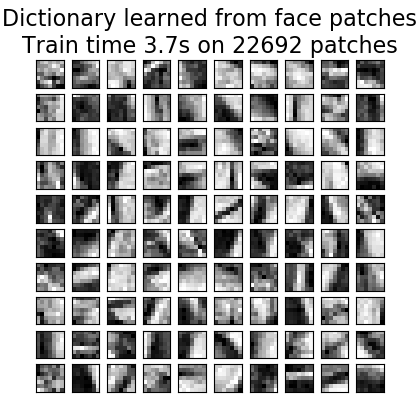
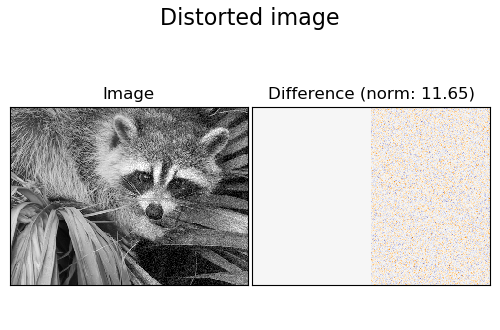
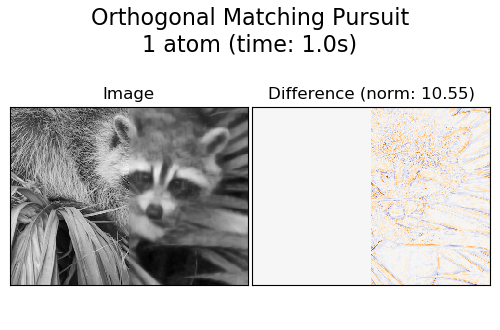
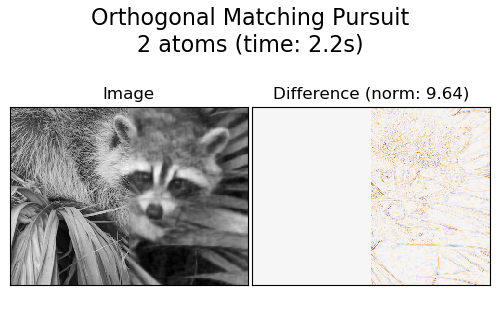
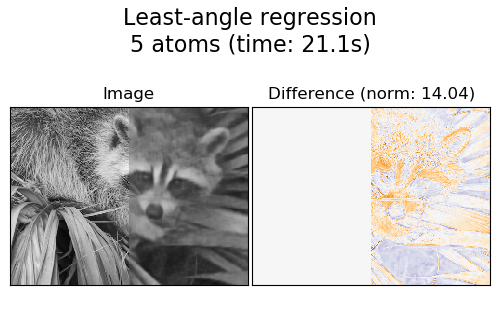
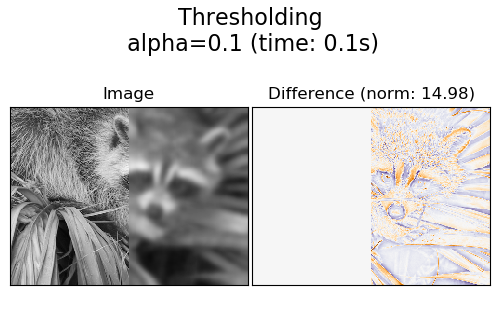
Distorting image...
Extracting reference patches...
done in 0.01s.
Learning the dictionary...
done in 3.70s.
Extracting noisy patches...
done in 0.00s.
Orthogonal Matching Pursuit
1 atom...
done in 0.96s.
Orthogonal Matching Pursuit
2 atoms...
done in 2.18s.
Least-angle regression
5 atoms...
done in 21.14s.
Thresholding
alpha=0.1...
done in 0.14s.
print(__doc__)
from time import time
import matplotlib.pyplot as plt
import numpy as np
import scipy as sp
from sklearn.decomposition import MiniBatchDictionaryLearning
from sklearn.feature_extraction.image import extract_patches_2d
from sklearn.feature_extraction.image import reconstruct_from_patches_2d
try: # SciPy >= 0.16 have face in misc
from scipy.misc import face
face = face(gray=True)
except ImportError:
face = sp.face(gray=True)
# Convert from uint8 representation with values between 0 and 255 to
# a floating point representation with values between 0 and 1.
face = face / 255.
# downsample for higher speed
face = face[::4, ::4] + face[1::4, ::4] + face[::4, 1::4] + face[1::4, 1::4]
face /= 4.0
height, width = face.shape
# Distort the right half of the image
print('Distorting image...')
distorted = face.copy()
distorted[:, width // 2:] += 0.075 * np.random.randn(height, width // 2)
# Extract all reference patches from the left half of the image
print('Extracting reference patches...')
t0 = time()
patch_size = (7, 7)
data = extract_patches_2d(distorted[:, :width // 2], patch_size)
data = data.reshape(data.shape[0], -1)
data -= np.mean(data, axis=0)
data /= np.std(data, axis=0)
print('done in %.2fs.' % (time() - t0))
# #############################################################################
# Learn the dictionary from reference patches
print('Learning the dictionary...')
t0 = time()
dico = MiniBatchDictionaryLearning(n_components=100, alpha=1, n_iter=500)
V = dico.fit(data).components_
dt = time() - t0
print('done in %.2fs.' % dt)
plt.figure(figsize=(4.2, 4))
for i, comp in enumerate(V[:100]):
plt.subplot(10, 10, i + 1)
plt.imshow(comp.reshape(patch_size), cmap=plt.cm.gray_r,
interpolation='nearest')
plt.xticks(())
plt.yticks(())
plt.suptitle('Dictionary learned from face patches\n' +
'Train time %.1fs on %d patches' % (dt, len(data)),
fontsize=16)
plt.subplots_adjust(0.08, 0.02, 0.92, 0.85, 0.08, 0.23)
# #############################################################################
# Display the distorted image
def show_with_diff(image, reference, title):
"""Helper function to display denoising"""
plt.figure(figsize=(5, 3.3))
plt.subplot(1, 2, 1)
plt.title('Image')
plt.imshow(image, vmin=0, vmax=1, cmap=plt.cm.gray,
interpolation='nearest')
plt.xticks(())
plt.yticks(())
plt.subplot(1, 2, 2)
difference = image - reference
plt.title('Difference (norm: %.2f)' % np.sqrt(np.sum(difference ** 2)))
plt.imshow(difference, vmin=-0.5, vmax=0.5, cmap=plt.cm.PuOr,
interpolation='nearest')
plt.xticks(())
plt.yticks(())
plt.suptitle(title, size=16)
plt.subplots_adjust(0.02, 0.02, 0.98, 0.79, 0.02, 0.2)
show_with_diff(distorted, face, 'Distorted image')
# #############################################################################
# Extract noisy patches and reconstruct them using the dictionary
print('Extracting noisy patches... ')
t0 = time()
data = extract_patches_2d(distorted[:, width // 2:], patch_size)
data = data.reshape(data.shape[0], -1)
intercept = np.mean(data, axis=0)
data -= intercept
print('done in %.2fs.' % (time() - t0))
transform_algorithms = [
('Orthogonal Matching Pursuit\n1 atom', 'omp',
{'transform_n_nonzero_coefs': 1}),
('Orthogonal Matching Pursuit\n2 atoms', 'omp',
{'transform_n_nonzero_coefs': 2}),
('Least-angle regression\n5 atoms', 'lars',
{'transform_n_nonzero_coefs': 5}),
('Thresholding\n alpha=0.1', 'threshold', {'transform_alpha': .1})]
reconstructions = {}
for title, transform_algorithm, kwargs in transform_algorithms:
print(title + '...')
reconstructions[title] = face.copy()
t0 = time()
dico.set_params(transform_algorithm=transform_algorithm, **kwargs)
code = dico.transform(data)
patches = np.dot(code, V)
patches += intercept
patches = patches.reshape(len(data), *patch_size)
if transform_algorithm == 'threshold':
patches -= patches.min()
patches /= patches.max()
reconstructions[title][:, width // 2:] = reconstruct_from_patches_2d(
patches, (height, width // 2))
dt = time() - t0
print('done in %.2fs.' % dt)
show_with_diff(reconstructions[title], face,
title + ' (time: %.1fs)' % dt)
plt.show()
脚本的总运行时间:(0分30.682秒)




